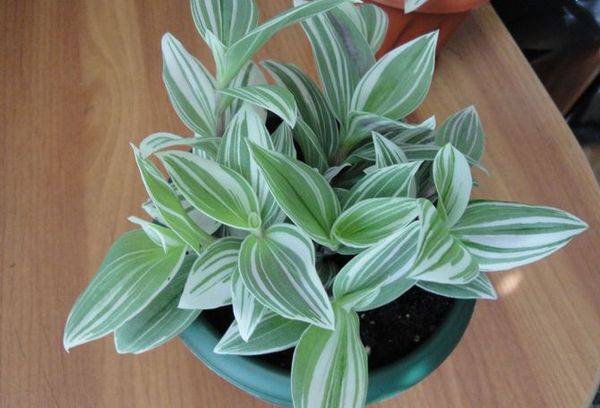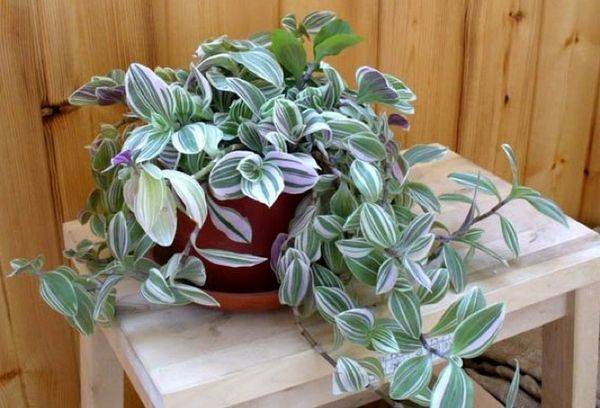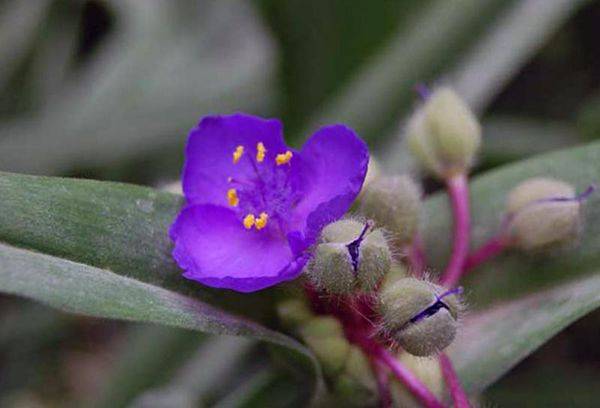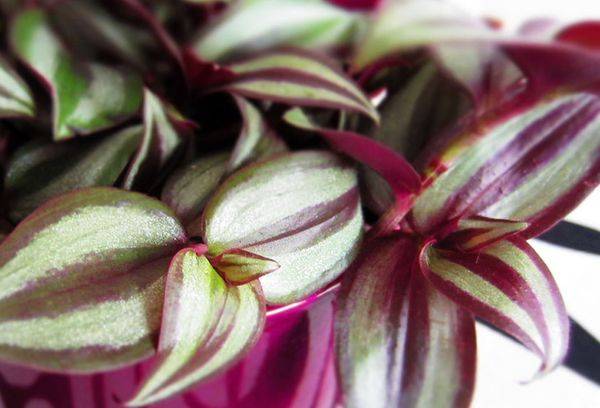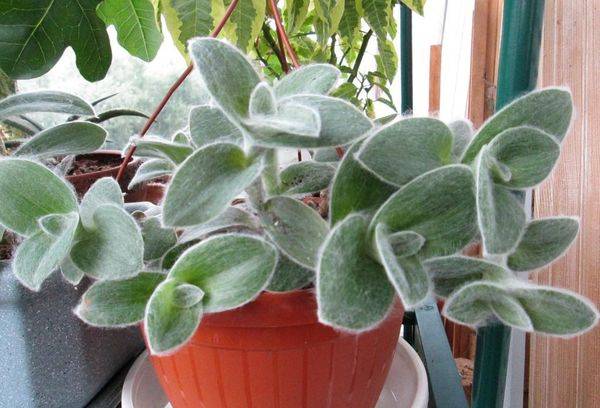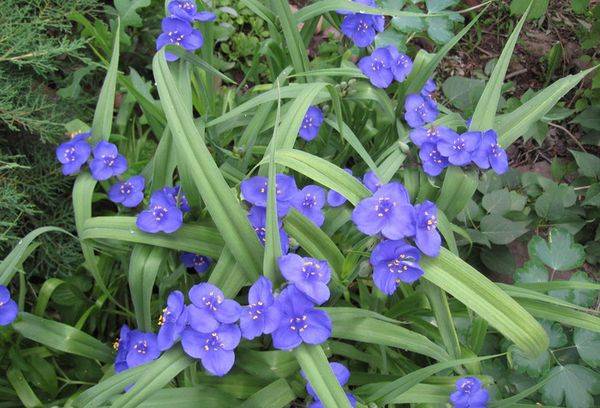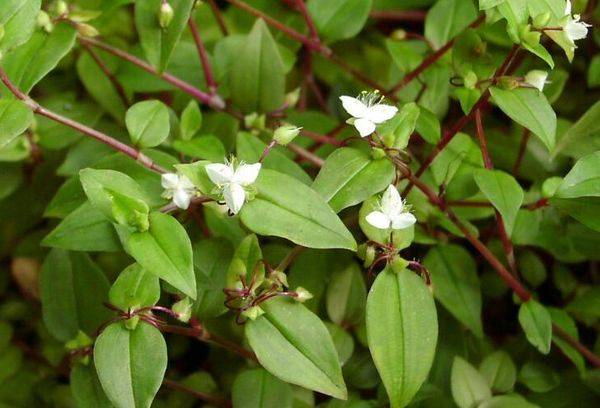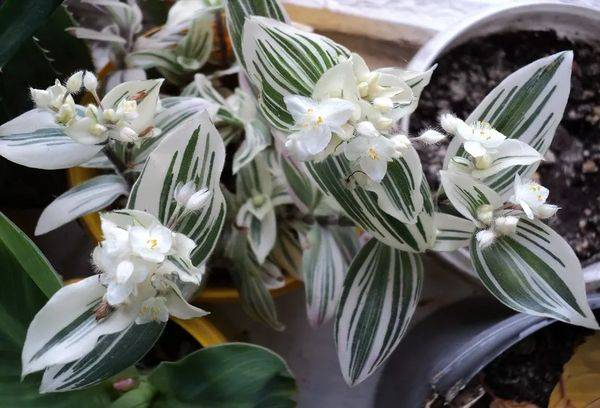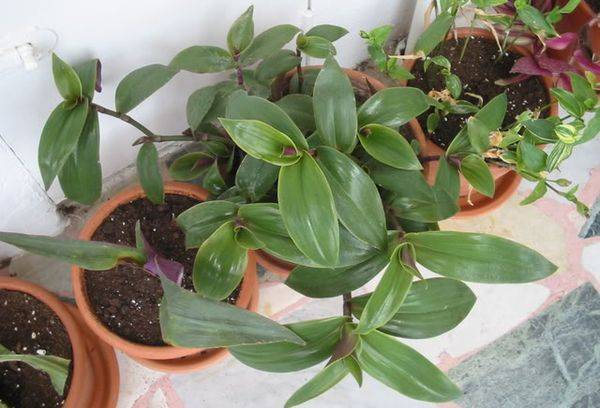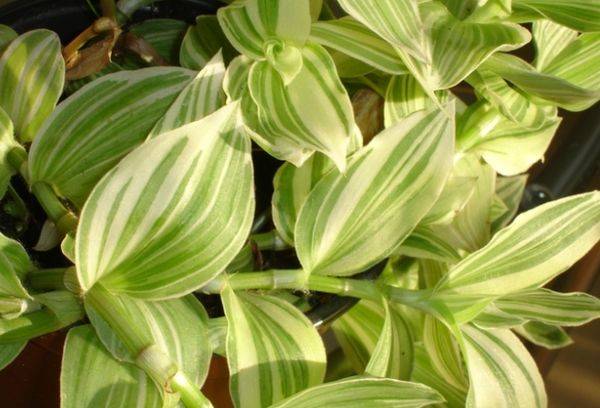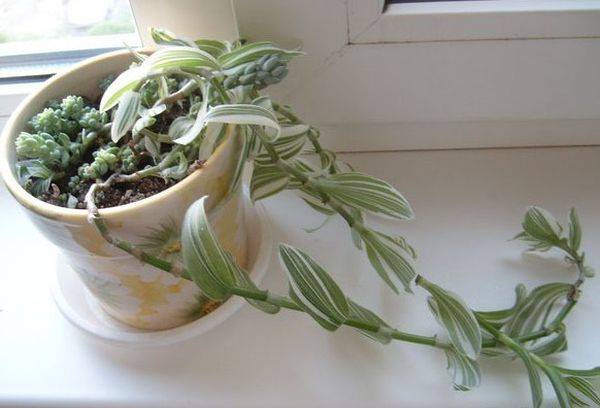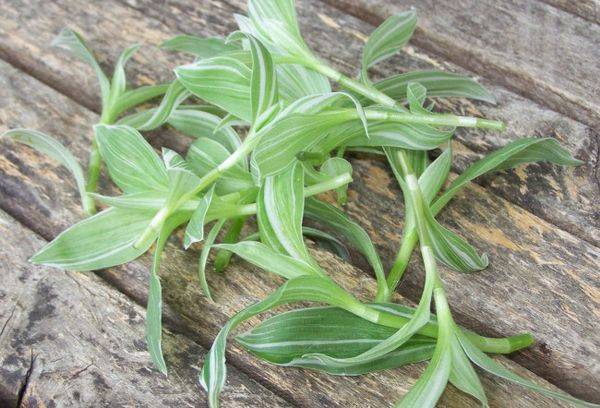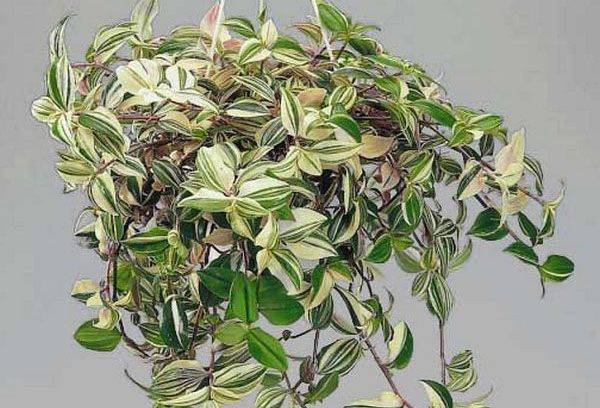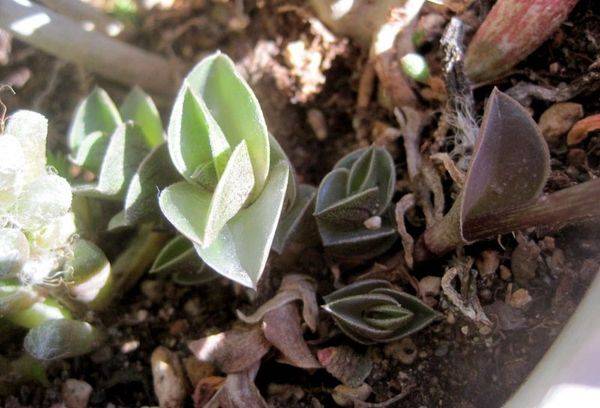How to care for tradescantia at home
Content:
Natural tradescantia grow in the temperate and tropical zones of America, spread from southern Canada to northern Argentina. Plants of this genus are often grown as indoor plants, because many gardeners are interested in what care the home tradescantia needs.
Description
Tradescantia is a perennial plant, stunted and grassy, with straight or creeping shoots. The leaves are elliptical, lanceolate, located on the stem next. Inflorescences are in the sinuses of the upper leaves or apical.
Plants of the genus Tradescantia are widespread due to the ease of care for them, often used as ampelous.
Tip
To get a thick green shoots, pinch the plant, this technique allows you to strengthen the branching.
Indoors, place the tradescantia so that its shoots hang freely. Hanging containers (planters, vases) are perfect for these purposes, another option is to put the pot on a shelf or on high furniture.
Tradescantia blooms in an apartment: at the ends of long shoots appear bluish or blue-violet flowers.
Kinds
30 species of the genus Tradescantia are known, the most popular are:
- Tradescantia Virgin - The first species that was introduced to Europe. Plants are low, with shortened shoots, on which there are two rows, folded in half along the vein and fused at the top of the leaves. At the base of the leaves, thin long hairs are distinguishable. Flowers appear at the ends of erect shoots and bloom in the morning, they are large, purple or blue. Flowering is continuous, as some flowers are constantly replaced by others. The Virginia tradescantia winters fine in open ground without shelter in southern Russia.
- Zebra-like tradescantia (zebrina) has a fleshy brittle stem. Below, the leaves are red, on the outside - on the green background are two silver-white stripes. Plants of the species are undemanding to care at home. It blooms with small purple, pink and purple, purple flowers. Hanging shoots, for this reason, plants are often used as ampelous.
- Tradescantia sillamontana - plants are covered with thick white felt, which allows them to retain moisture and protect themselves from aggressive sunlight. The lack of lighting leads to a reduction in the edge. Leaflets are arranged on a shoot in a spiral. The stems are straight, do not lie down for a long time, so it is not recommended to use ampelous plants. Well propagated by cuttings.
- Tradescantia Anderson able to grow in almost any environment. Many varieties of the species are known, differing in shades, which can be pink, white, blue, blue. The bush is usually all dotted with flowers due to the large number of shoots.
- Tradescantia Riverside - has thin purple stems. The leaves are green on top and purple (or with purple spots) on the underside. It blooms profusely, flowers are white, small. There are varieties with soft yellow stripes on green leaves, lilac-pink-white. The peculiarity of the new variety “girlish blush” - young leaves are pink, but if the flower is in the shade, then they turn green.
- White-flowered tradescantia - a herbaceous plant with creeping shoots. It blooms in very rare cases, the flowers are white (which is the name). Characteristic feature of the form glbovittataRelated to this species are white stripes on the leaves. On yellow leaves Aurea - green stripes. There are varieties with tri-color, bright green, whitish-green leaf plates, as well as with golden stripes.
- Tradescantia Blossfeld - the leaves are larger than the rest of the species, oblong or in the form of an ellipse, dark green, reddish in the upper part, and purple below. The variegated variety looks very beautiful: the cream-green color of the leaves have a pink coating. The most widespread variety Variegata (translated as "motley"), a feature of which are rare green and yellow stripes on leaf plates.
Home Care
Tradescantia belongs to perennials, but it is necessary to rejuvenate it every two years, and in some cases annually. This is because over time and as the flower grows, its lower leaves dry out. This greatly spoils the appearance of the plant, since the stem is exposed. A timely transplant will help prevent this.
Lighting. It is not required to create shade of the tradescantia, it is a plant that prefers direct sunlight. The flower will develop well in partial shade. When choosing ideal lighting conditions, the variety should be considered. Variegated tradescanti become brighter and more beautiful in a well-lit room. Plants with monophonic leaves under the direct rays of the sun fade, and in partial shade the beautiful green color returns to them again.
Temperature. Tradescantia perfectly develops in a warm and cool room. The thermometer column in the room should not fall below + 10 ° C. For white-flowered tradescantia, the lower limit of the temperature regime is + 7 ° C. Drafts are not dangerous for all species.
Watering. From spring to autumn, the flower needs constant watering, while it is impossible to fill the plant. Water stagnation must not be allowed, but the earthen lump must always be wet. In winter, watering must be reduced, but even then the soil should remain slightly moist.
Tip
Defend the water that will be used for irrigation.
There is no need to constantly spray the flower, but there will be no harm from them, especially in the winter after the start of the heating season. It is allowed to spray the plant several times a day with well-settled water.
Priming. Tradescantia feels great in ordinary land, but there may be pests in it. For this reason, it is preferable to use a ready-made soil mixture purchased in a flower shop as a substrate for the plant.
To make a suitable soil yourself, you will need:
- 2 parts of leaf humus;
- 1 part of turf;
- 1 part of sand.
Tip
purityis.decorexpro.com/en/ recommends that you bake each component in the oven before mixing. This will save them from pathogens and pests.
Top dressing. Every two weeks in spring and summer, the tradescantia needs to be fed. In winter, the number of top dressings should be reduced to once every one and a half months. As fertilizers, any mineral and organic compounds are suitable, but for varieties with variegated leaves, you need to buy special mixtures. Top dressing must necessarily be combined with watering.
Reproduction and transplantation
Tradescantia propagates in an extremely simple way - by grafting. Rooting takes place very quickly, in addition, to plant a flower in this way is allowed all year round. Short daylight hours during the winter months cause slow rooting; in autumn, spring and summer, roots usually appear after 14 days.
Tip
The plant from which the cuttings will be taken must be young, with at least six sections.
The substrate for planting cuttings is composed of three components, taken in equal proportions: humus, sand and compost soil.
In the spring, the best option for propagation are seeds that are best planted, starting in March, in mini-greenhouses.The best option for planting seeds is a mixture of peat and sand, which are taken in equal proportions. The most suitable temperature for the seeds to sprout is + 20 ° C. From time to time, the mini-greenhouse needs to be ventilated, and the soil moistened with a spray bottle. As soon as the seeds germinate, they must be sprayed often. Tradescantia obtained from seeds begin to bloom in the third year of life.
Pests and diseases
The appearance of diseases and pests depends, first of all, on the conditions in which the flower is grown. A prolonged stay in a hot room with dry air contributes to the defeat of the spider mite, scutes, aphids.
It is not difficult to get rid of guards, for this it is enough to wipe the leaves of tradescantia with cotton wool soaked in alcohol or soap solution 4 times a week. Such a systematic cleaning helps to weaken the scutes, as a result of which they disappear. In case of severe defeat, the best option would be to use a special drug purchased in the store.
When the aphids are damaged, which eats or damages young leaves and shoots, the tradescantia begins to turn yellow. As a result, the leaves die off, dry, lose their color. In addition, aphids secrete juice, which is an excellent habitat for the soot fungus, the development of which is a deterioration in the process of photosynthesis. An effective way to combat aphids is to treat the flower with a solution of ordinary laundry soap. With a severe defeat, any insecticide will help.
Tip
Aphids are sensitive to dandelion tincture. Pour 2 or 3 tablespoons of fresh leaves or dandelion roots into 1 liter of water, the temperature of which should not be higher than 40 ° C, let it brew for two hours in a cool place. Spray tradescantia every 8 days until the aphid is completely destroyed.
The prevention of the appearance of the spider mite is the ventilation of the room where the tradescantia is located. If the pest still wound up, insecticide treatment will help get rid of it.
Useful Tips
Tradescantia is unpretentious in leaving, but nevertheless some errors can affect the appearance of the plant:
- Yellow spots on the leaves and stunted plant growth indicate insufficient moisture and nutrient deficiency. Increase watering and fertilize.
- In variegated varieties, the leaves become green or plain as a result of a lack of light. Move the plant to a place where it will receive more light.
- Leaves that have become plain indicate incorrect pruning or incorrectly cuttings.
Tip
Place a flowerpot with a young tradescantia on the glass of the aquarium - the growing shoots will fall into the water after a while, forming a green carpet on the surface.
Tradescantia Properties
The plant will delight its owners not only with its appearance, it has a number of useful characteristics:
- helps to moisturize and purify air in the room;
- contains nutrients and medicinal substances;
- neutralizes harmful electromagnetic radiation.
